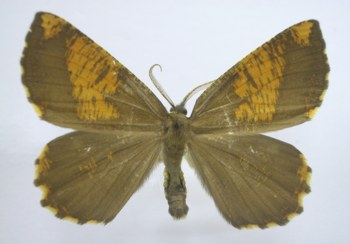Pests
Angerona prunaria Linnaeus - Orange Moth.
Taxonomic position.
Class Insecta, order Lepidoptera, family Geometridae, genus Angerona.Biological group.
Polyphagous pest of fruit and berry cultures and foliaceous trees.Morphology and biology.
Color of wings variable. Forewing usually light orange in male, light-ocher in female, with numerous dark-brown interrupted stripes usually merging into regular spots at base and at apex of wing (wingspan 40-45 mm). Fringe light-orange or yellow with dark gray spots at vein apices. Egg flattened-oval. Caterpillar brown-gray, gradually thickened from thorax toward 6th segment; 8th segment with sharp tubercles, 4-9th and 12th segments with smaller tubercles. Pupa 17.2-18.5 mm, brown, reddish at apex; fore femora are not visible. Cremaster large, rounded in back part, with 4 pairs of hooks. Caterpillars of 3rd-4th instars winter between leaves plaited by web. In spring the caterpillars eat leaves. Pupation occurs within weak web cocoon between leaves on ground surface. Females lay up to 250 eggs in small groups, usually on lower side of leaves.Distribution.
The species inhabits Western and Middle Europe, Mongolia, Northern China, Korea, Japan; adventive species in Northern America. In the former USSR it is distributed in the European part, Baltics, Byelorussia, Ukraine (including Crimea), the Northern Caucasus, Transcaucasia, Ural, Northern Kazakhstan, Kirghizia, Southern and Eastern Siberia, Altai, the Far East (Primorskii and Khabarovsk Territories, Amur and Sakhalin Regions, Kunashir).Ecology.
Monovoltine species. In spring the caterpillars continue developing until the middle of May or beginning of June. Moths fly from the beginning or middle of June until the beginning of August; in Polesye and forest-steppes of Ukraine, until the beginning of July. In the afternoon they hide among fallen leaves or in tree crones, becoming active at twilight.Economic significance.
Polyphagous caterpillars feed on plum, cherry, apricot, sloe, bird cherry, hawthorn, mountain ash, chokeberry, raspberry, rose, currant, gooseberry, hazel, and also on birch, alder, willow, poplar, hornbeam, beech, buckthorn, honeysuckle, elder, aralia, blueberry, bilberry, heather, Labrador tea, stone berry, plantain, and dandelion. Insecticide treatments of fruiters in spring against a pest complex of leaf-eating lepidopterans eradicate caterpillars of the Orange Moth.Reeference citations:
Belyaev E.A. 1988. Family Geometridae. In: Kirpichnikova V.A. & Ler P.A., eds. Butterflies - pests of the Far Eastern agriculture. Keys. Vladivostok: DVO AN SSSR, p. 130-149 (in Russian).Milyanovskii E.S. 1974. Family Geometridae. In: Vasil.ev V.P., ed. Pests of agricultural crops and forest plantations. V.2. Arthropods. Kiev: Urozhai, p. 343-352 (in Russian).
Mironov V.G. 1999. Family Geometridae. In: Kuznetsov V.I., ed. Insects and mites - pests of agricultural crops. Lepidoptera. St. Petersburg: Nauka. V. 3(2). p. 254-273 (in Russian).
Savkovskii P.P. 1976. Atlas of the pests of fruit and berry plants. Kiev: Urozhai. 207 p. (in Russian).
Vasil.ev V.P., Livshits I.Z. 1984. Pests of fruit crops. Moscow: Kolos, 399 p. (in Russian).


